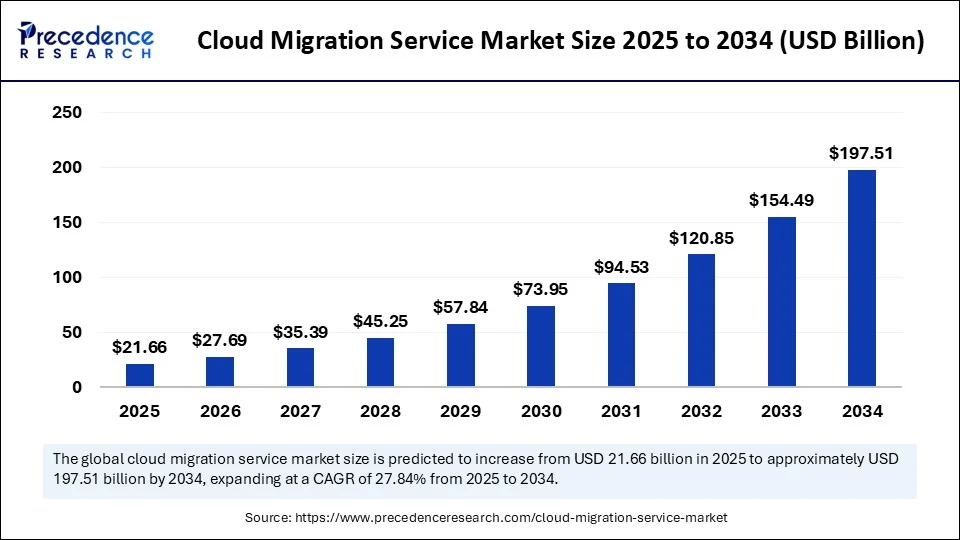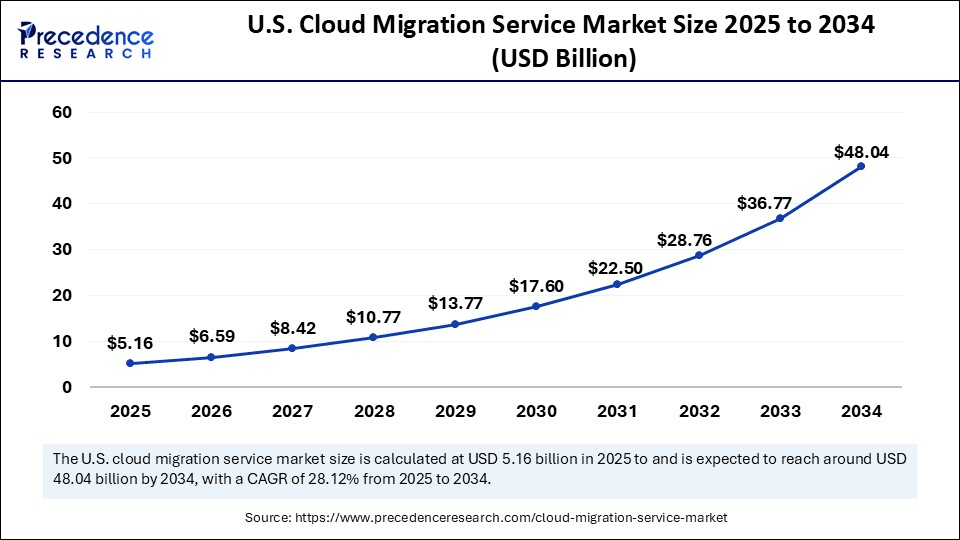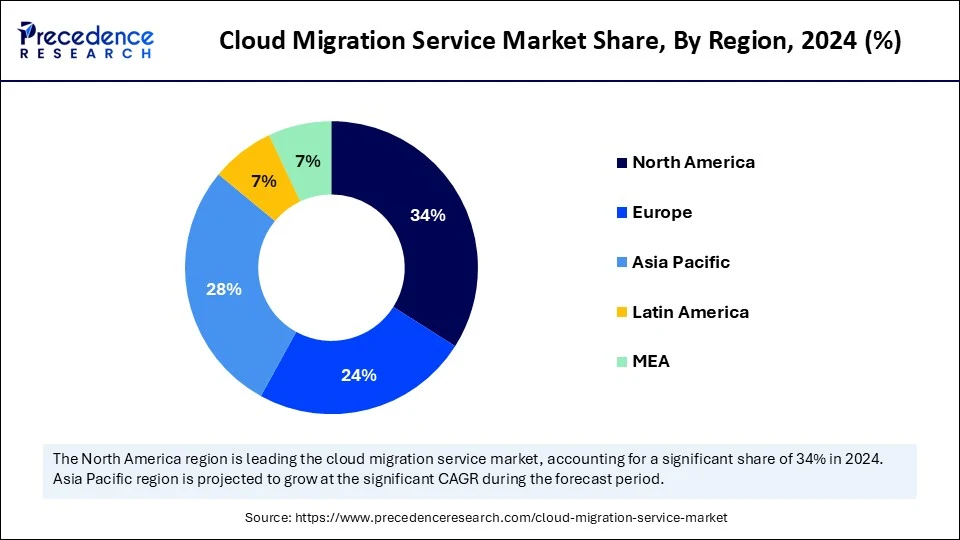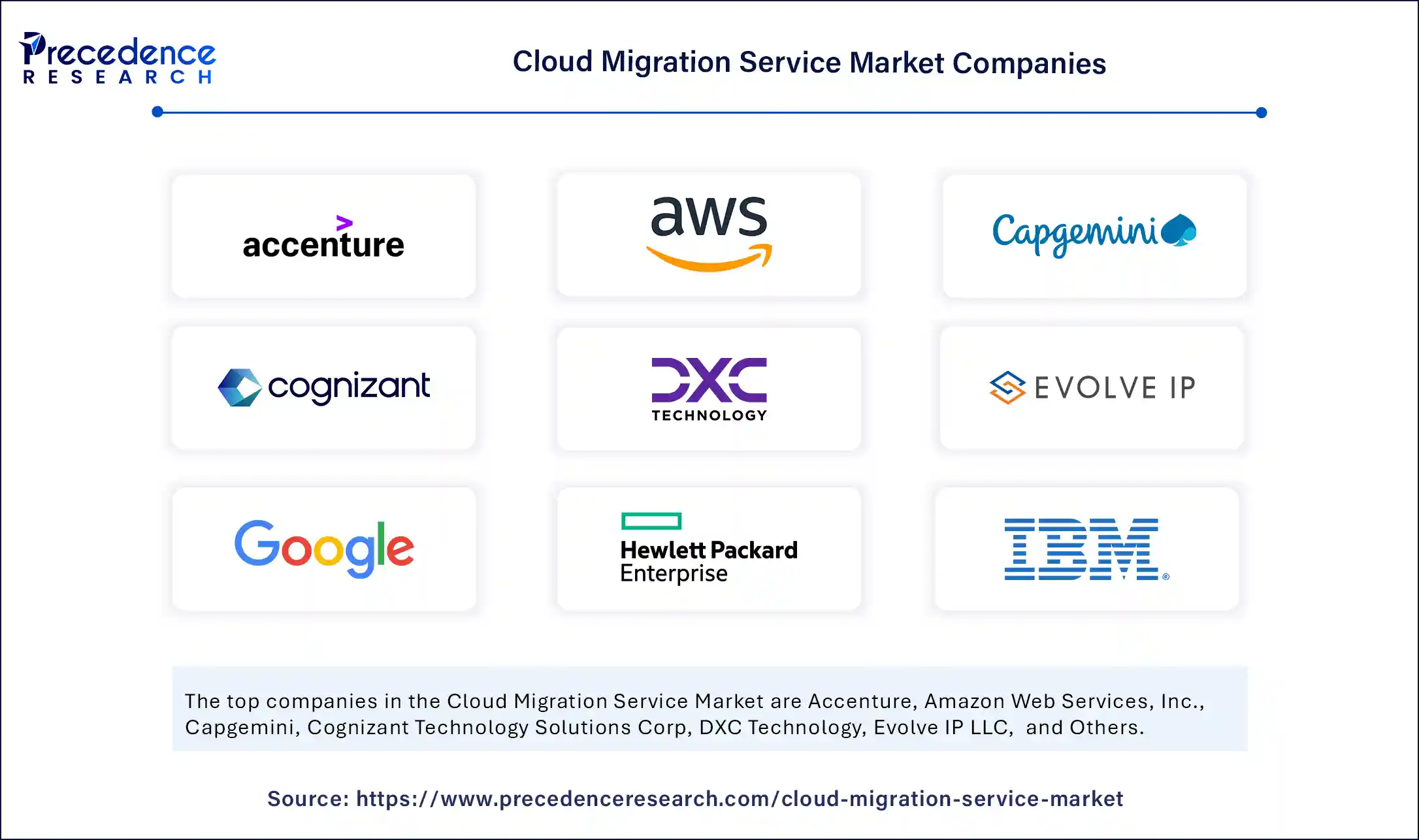List of Contents
Cloud Migration Services Market Size and Forecast 2025 to 2034
The global cloud migration services market size accounted for USD 16.94 billion in 2024 and is predicted to increase from USD 21.66 billion in 2025 to approximately USD 197.51 billion by 2034, expanding at a CAGR of 27.84% from 2025 to 2034. The growth of the market is attributed to the rapid shift toward cloud environment to improve collaboration and productivity.

Cloud Migration Service Market Key Takeaways
- In terms of revenue, the global cloud migration services market was valued at USD 16.94 billion in 2024.
- It is projected to reach USD 197.51 billion by 2034.
- The market is expected to grow at a CAGR of 27.84% from 2025 to 2034.
- North America dominated the cloud migration services market with the largest share of 34% in 2024.
- Asia Pacific is expected to expand at the fastest CAGR during the forecast period.
- By offering, the solutions segment led the market in 2024.
- By offering, the services segment is expected to grow at the highest CAGR in the upcoming period.
- By deployment, the public cloud segment captured the biggest market share in 2024.
- By deployment, the hybrid cloud segment is expected to show the highest CAGR in the coming years.
- By organization size, the large enterprises segment contributed the highest market share in 2024.
- By organization size, the SMEs segment is likely to grow at a significant CAGR between 2025 and 2034.
- By end use, the IT and telecommunications segment generated the major market share in 2024.
- By vertical, the healthcare segment is likely to grow at the fastest CAGR during the forecast period.
Impact of AI on the Cloud Migration Services Market
AI is significantly impacting the cloud migration services market by automating and optimizing various stages of the migration process. AI-powered tools can assess existing IT infrastructure, identify dependencies, and recommend the most efficient migration strategies. This automation reduces manual effort, accelerates migration timelines, and minimizes the risk of human error. AI also enhances the post-migration phase. Machine learning algorithms can monitor cloud environments, predict performance bottlenecks, and optimize resource allocation. This proactive approach ensures that migrated applications run smoothly and efficiently, leading to improved cost management and enhanced user experience.
U.S. Cloud Migration Service Market Size and Growth 2025 to 2034
The U.S. cloud migration services market size was evaluated at USD 4.03 billion in 2024 and is projected to be worth around USD 48.04 billion by 2034, growing at a CAGR of 28.12% from 2025 to 2034.

What Factors Contribute to North America's Dominance in the Cloud Migration Services Market in 2024?
North America dominated the cloud migration services market while holding the largest share in 2024. The region's dominance in the market stems from its robust IT infrastructure and early adoption of new technologies. Many major IT companies and cloud service providers are headquartered in the U.S. There is rapid adoption of cloud technology by tech giants and the shift of IT resources to cloud platforms, which further drive the demand for cloud migration services in this region. There is a high adoption of hybrid cloud solutions, which combine public and private cloud environments, creating opportunities for service providers to offer integrated migration and management services. The region also boasts well-developed healthcare IT infrastructure, boosting the adoption of cloud solutions to optimize healthcare delivery, contributing to market growth.

European Cloud Migration Services Market Trends
Europe is expected to grow at a notable rate in the upcoming period. The widespread use of business intelligence software and data analytics tools demands robust cloud infrastructure. The increasing reliance of the healthcare industry on cloud platforms for real-time data access and monitoring also boost the market growth. Furthermore, government policies focused on data security and addressing data breach challenges are fostering the adoption of cloud solutions. The region has a well-developed IT infrastructure, facilitating the seamless integration of cloud solutions, contributing to market growth.
Asia Pacific Cloud Migration Services Market
Asia Pacific is expected to expand at the fastest CAGR during the forecast period. This is mainly due to the rapid expansion of IT and telecommunications businesses, especially in countries like China, India, and Japan. Various businesses, especially SMEs, in the region are rapidly shifting toward cloud environment to reduce operational costs. Rapid digital transformation across various industries, expanding IT infrastructure, and the growing presence of cloud service providers are also contributing to market expansion.
Market Overview
Businesses are increasingly using cloud platforms for services like Infrastructure as a Service, Platform as a Service, and Software as a Service, due to the high efficiency, robustness, and affordability of cloud services. Many businesses still have traditional on-premises data centers. To stay updated with the latest technology, businesses need to migrate their resources, such as applications and databases, to cloud servers, whether public, hybrid, or private
Service providers help in the initial assessment for the migration process by analyzing the existing infrastructure and dependencies, and determining the best migration process. After a proper assessment plan, they perform the complete operation of data migration for the organization. Data security, as per standard policy and regulations, is managed by the cloud migration service provider, and post-migration support is also provided, making the process smooth and hassle-free. To stay updated with technology, businesses are adopting cloud platforms and cloud migration services, which boosts the market growth.
Cloud Migration Service Market Growth Factors
- The increasing demands for agility and automation in businesses drive the need for faster scaling, flexible resource allocation, and streamlined process automation, significantly boosting the growth of the market.
- The growing shift of businesses toward hybrid and multi-cloud models is driving the demand for cloud migration services.
- The growing need to reduce operational costs and improve productivity is likely to boost market growth. Businesses are considering cloud platforms over on-premises platforms due to their low cost, high scalability, and robust security measures.
- Rising need to enhance security and disaster recovery further boosts investment in cloud solutions. Cloud providers offer robust security measures and disaster recovery capabilities, protecting data and applications from threats and ensuring business continuity.
Market Scope
| Report Coverage | Details |
| Market Size by 2034 | USD 197.51 Billion |
| Market Size in 2025 | USD 21.66 Billion |
| Market Size in 2024 | USD 16.94 Billion |
| Market Growth Rate from 2025 to 2034 | CAGR of 27.84% |
| Dominating Region | North America |
| Fastest Growing Region | Asia Pacific |
| Base Year | 2024 |
| Forecast Period | 2025 to 2034 |
| Segments Covered | Platform, Offering, Deployment, Organization Size, Vertical, and Region |
| Regions Covered | North America, Europe, Asia-Pacific, Latin America, and Middle East & Africa |
Market Dynamics
Drivers
Increasing Digitization and Remote Work
Digital transformation is a major factor boosting the growth of the cloud migration services market. As businesses undergo digital transformation, there is high demand for cloud solutions that support digital technologies. Cloud migration is a key enabler of digital transformation, allowing businesses to modernize their IT infrastructure and leverage emerging digital technologies like AI and IoT. With the rising digitization, the volume of data is also rising, encouraging businesses to shift toward cloud solutions that offer scalable storage and processing capabilities. Moreover, the rise of remote work has increased the demand for cloud services, as they enable employees to access data and applications from any location. As adoption of remote work rises, so does the need for cloud services, as they enable remote collaboration.
Restraint
Lack of Skilled and Knowledgeable Workforce and Complexity of Migration
Migrating complex IT environments to the cloud can be challenging, requiring careful planning, execution, and expertise. Organizations are facing hurdles in finding skilled IT professionals for cloud migration, deployment, and maintaining project security. Various technical issues arise during integrating cloud solutions in existing infrastructure, requiring proper maintenance by highly skilled IT professionals, especially in cloud platform security management. Data privacy issues and strict government regulations pose challenges to consistency. All these factors create challenges and hamper the growth of the market.
Opportunity
Rising Demand For Hybrid Cloud Solutions and Specialized Services
The rising demand for hybrid cloud solutions and specialized migration services create immense opportunities in the cloud migration services market. Hybrid cloud solutions offer businesses the flexibility to combine public and private cloud resources, catering to diverse needs. The integration of hybrid cloud solutions is complex, which drives the need for specialized migration services to ensure seamless integration and management. Moreover, as organizations increasingly adopt hybrid cloud models to meet their specific needs, the demand for expert assistance in migrating and optimizing these environments grows.
Offering Insights
Why Did the Solutions Segment Dominate the Cloud Migration Services Market in 2024?
The solutions segment dominated the market with the largest share in 2024. This is mainly due to the increased shift of businesses toward cloud environment. As businesses migrate their operations to the cloud, they need to transfer vast amounts of data and re-architect their existing infrastructure to function effectively in the new environment. This transition requires specialized solutions to ensure data integrity, minimize downtime, and optimize performance.
On the other hand, the services segment is expected to grow at the fastest CAGR over the projection period. As the adoption of cloud solutions rises, so does the need for integration, installation, and maintenance services. The increasing complexity of cloud environments and the diverse needs of businesses drive the demand for specialized services like consulting, migration, and managed services. Migrating toward hybrid and multi-cloud environments is challenging, creating the need for professional services to manage and integrate these complex environments.
Deployment Insights
What Made Public Cloud the Dominant Segment in the Market?
The public cloud segment dominated the cloud migration services market in 2024. The segment's dominance stems from the increased adoption of software-as-a-service applications. Organizations are increasingly moving resources to the public cloud, utilizing cloud-native applications vital for remote work, large file transfers, and virtual meetings. This shift, along with the growth in cloud-based tools like customer relationship management and enterprise resource planning applications, further bolsters the growth of the public cloud segment.
The hybrid cloud segment is expected to grow at the fastest rate in the coming years. The growth of the segment is attributed to the increasing concern over data security. Many organizations, especially in sectors like finance and healthcare, prioritize high security for sensitive data. This significantly boosts the adoption of hybrid model, as it keeps sensitive data on-premises while making accessible data available on the cloud. This approach is practical for businesses with stringent data privacy regulations that prevent complete reliance on public clouds, making hybrid cloud solutions highly feasible.
Organization Size Insights
How Does the Large Enterprises Segment Dominate the Cloud Migration Services Market in 2024?
The large enterprises segment dominated the market with a major share in 2024. This is mainly due to thier substantial IT infrastructure requirement, which encourage them to shift toward cloud technology over on-premises solutions. Cloud services meet their need for centralized and decentralized databases and servers, ensuring constant accessibility to data and operational files. Large enterprises experience fluctuating demands for IT resources. However, cloud services allow them to scale up or down as needed, optimizing costs and ensuring that they have the resources required during peak times.
Meanwhile, the small and medium enterprises segment is likely to grow at a significant CAGR during the forecast period. The growth of the segment is attributed to the rapid shift of SMEs toward cloud environments for their reduced operational costs and high flexibility and scalability. Cloud solutions enable SMEs to eliminate large upfront investments in hardware and software, paying only for the resources they use. Cloud platforms provide scalability, allowing SMEs to adjust their IT resources as needed, supporting business growth without significant capital expenditures.
Vertical Insights
What Made IT & Telecommunications the Dominant Segment in the Market?
The IT & telecommunications segment led the market in the year 2024. This is mainly due to the increased need for business agility. Cloud migration accelerates the development and deployment of new applications and services. There is a heightened adoption of AI, machine learning, and big data analytics among IT businesses, requiring substantial computational power and storage, which can be a costly investment for many organizations. However, adopting cloud infrastructure is a more feasible and practical solution for IT and telecommunications businesses, offering greater flexibility, scalability, and security compared to on-premises solutions.
The healthcare segment is expected to grow at the highest CAGR in the upcoming future, driven by the increasing adoption of digital technologies. There is significant rise in the integration of digital solutions, like electronic health records (EHR), remote patient monitoring, and sophisticated diagnostic solutions, in healthcare organizations. This creates the need for cloud solutions to store and manage data generated from these solutions. Moreover, increasing need to store large patient data for clinical studies further supports market growth.
Cloud Migration Service Market Companies

- Accenture
- Amazon Web Services, Inc.
- Capgemini
- Cognizant Technology Solutions Corp
- DXC Technology
- Evolve IP LLC
- Google LLC
- Hewlett Packard Enterprise Development LP
- IBM Corporation
- Kyndryl Inc.
- Microsoft
- NTT DATA Americas, Inc.
- Oracle Corporation
- Rackspace Hosting Inc.
- SAP SE
- Sunrise Technologies
- Tata Communications
- Veritis Group Inc.
- VMware, Inc.
- Wipro
- WSM International LLC
Recent Developments
- In December 2024, Atlassian Corporation and Amazon Web Services (AWS) announced a multi-year strategic collaboration agreement (SCA) to expedite cloud transformation and deliver advanced AI and security capabilities to enterprise customers.
(Source: https://www.businesswire.com) - In April 2024, Tata Consultancy Services (TCS) entered into a strategic partnership with Amazon Web Services (AWS) to accelerate its customers' cloud transformation journey at scale. This new strategic transformation agreement with AWS will enable TCS to facilitate full-stack digital transformation of its customers by leveraging data and generative artificial intelligence (AI) solutions on AWS.
(Source: https://www.tcs.com)
Segments covered in the Report
By Platform
- Solution
- Infrastructure Migration
- Platform Migration
- Database Migration
- Application Migration
- Storage Migration
By Offering
- Solution
- Infrastructure Migration
- Platform Migration
- Database Migration
- Application Migration
- Storage Migration
- Service
- Professional Services
- Managed Services
By Deployment
- Public Cloud
- Private Cloud
- Hybrid
By Organization Size
- Large Enterprises
- Small & Medium-Sized Enterprises (SMEs)
By Vertical
- IT & Telecommunications
- BFSI
- Healthcare
- Government & Public Sector
- Manufacturing
- Automotive
- Retail & Consumer Goods
- Media & Entertainment
- Others
By Region
- North America
- Europe
- Asia Pacific
- Latin America
- Middle East & Africa
For inquiries regarding discounts, bulk purchases, or customization requests, please contact us at sales@precedenceresearch.com
Frequently Asked Questions
Ask For Sample
No cookie-cutter, only authentic analysis – take the 1st step to become a Precedence Research client